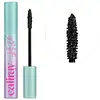What's inside
What's inside
 Key Ingredients
Key Ingredients

 Benefits
Benefits

 Concerns
Concerns

 Ingredients Side-by-side
Ingredients Side-by-side

Water
Skin ConditioningCopernicia Cerifera Wax
Stearic Acid
CleansingHydrogenated Jojoba Oil
AbrasiveGlyceryl Stearate
EmollientAcacia Senegal Gum
MaskingGlycerin
HumectantOryza Sativa Bran Wax
Skin ConditioningOleic/Linoleic/Linolenic Polyglycerides
EmollientShorea Robusta Resin
TonicOctyldodecanol
EmollientSr-Hydrozoan Polypeptide-1
HumectantCellulose
AbsorbentPectin
Emulsion StabilisingHydrolyzed Vegetable Protein
Skin ConditioningXanthan Gum
EmulsifyingAminomethyl Propanol
BufferingSodium Benzoate
MaskingPhenoxyethanol
PreservativeEthylhexylglycerin
Skin ConditioningCI 77499
Cosmetic ColorantWater, Copernicia Cerifera Wax, Stearic Acid, Hydrogenated Jojoba Oil, Glyceryl Stearate, Acacia Senegal Gum, Glycerin, Oryza Sativa Bran Wax, Oleic/Linoleic/Linolenic Polyglycerides, Shorea Robusta Resin, Octyldodecanol, Sr-Hydrozoan Polypeptide-1, Cellulose, Pectin, Hydrolyzed Vegetable Protein, Xanthan Gum, Aminomethyl Propanol, Sodium Benzoate, Phenoxyethanol, Ethylhexylglycerin, CI 77499
Water
Skin ConditioningStyrene/Acrylates Copolymer
Glyceryl Stearate
EmollientCopernicia Cerifera Wax
Microcrystalline Wax
Emulsion StabilisingCetearyl Alcohol
EmollientAcrylates Copolymer
Argania Spinosa Kernel Oil
EmollientPropanediol
SolventSynthetic Wax
AbrasiveTocopherol
AntioxidantCeteth-10 Phosphate
CleansingDicetyl Phosphate
EmulsifyingHydroxyacetophenone
AntioxidantHydroxyethylcellulose
Emulsion StabilisingSodium Citrate
BufferingSodium Hydroxide
BufferingPhenoxyethanol
PreservativeCaprylyl Glycol
EmollientEthylhexylglycerin
Skin ConditioningCI 77499
Cosmetic ColorantWater, Styrene/Acrylates Copolymer, Glyceryl Stearate, Copernicia Cerifera Wax, Microcrystalline Wax, Cetearyl Alcohol, Acrylates Copolymer, Argania Spinosa Kernel Oil, Propanediol, Synthetic Wax, Tocopherol, Ceteth-10 Phosphate, Dicetyl Phosphate, Hydroxyacetophenone, Hydroxyethylcellulose, Sodium Citrate, Sodium Hydroxide, Phenoxyethanol, Caprylyl Glycol, Ethylhexylglycerin, CI 77499
 Reviews
Reviews

Ingredients Explained
These ingredients are found in both products.
Ingredients higher up in an ingredient list are typically present in a larger amount.
Ci 77499 is also hydrated iron III oxide. It is created from mixing red and black iron oxides. This helps give shades of darkness to a product.
Iron III oxides are classified as inorganic chemicals for coloring.
Copernicia Cerifera Wax comes from a palm tree native to Brazil; another name for this ingredient is Carnauba Wax.
This ingredient is used to thicken texture and also leaves behind a film when applied.
Fun fact: This wax has the highest melting point of all natural waxes and low solubility.
Learn more about Copernicia Cerifera WaxEthylhexylglycerin (we can't pronounce this either) is commonly used as a preservative and skin softener. It is derived from glyceryl.
You might see Ethylhexylglycerin often paired with other preservatives such as phenoxyethanol. Ethylhexylglycerin has been found to increase the effectiveness of these other preservatives.
Glyceryl Stearate is a mix of glycerin and stearic acid.
It is used to stabilize the mixing of water and oil ingredients. By preventing these ingredients from separating, it can help elongate shelf life. It can also help thicken the product's texture.
As an emollient, it helps soften skin and supports barrier-replenishing ingredients.
In cosmetics, Glyceryl Stearate is often made from vegetable oils or synthetically produced.
This ingredient may not be fungal-acne safe
Fun fact: The human body also creates Glyceryl Stearate naturally.
Learn more about Glyceryl StearatePhenoxyethanol is a preservative that has germicide, antimicrobial, and aromatic properties. Studies show that phenoxyethanol can prevent microbial growth. By itself, it has a scent that is similar to that of a rose.
It's often used in formulations along with Caprylyl Glycol to preserve the shelf life of products.
Water. It's the most common cosmetic ingredient of all. You'll usually see it at the top of ingredient lists, meaning that it makes up the largest part of the product.
So why is it so popular? Water most often acts as a solvent - this means that it helps dissolve other ingredients into the formulation.
You'll also recognize water as that liquid we all need to stay alive. If you see this, drink a glass of water. Stay hydrated!
Learn more about Water